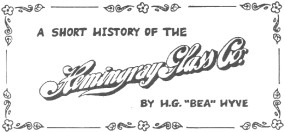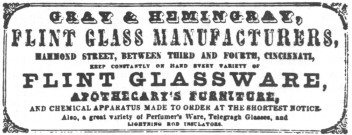A Short History of the Hemingray Glass Co. - Part 1 of 4
by H. G. "BEA" HYVE
Reprinted from "INSULATORS - Crown Jewels of the Wire", January 1982, page 3
Few things in this world are as pretty as the compound called glass. Webster's
Dictionary defines it as "a hard, brittle substance, usually transparent or
translucent, made by fusing silicates with soda or potash, lime, and,
sometimes, various metallic oxides." Just when man began making this unique
material is not known for certain. But glass beads have been found in Egypt that
are believed to be some 4,000 years old. Job, the Biblical character who lived
more than 3,000 years ago, listed glass alongside gold for preciousness, when he
stated that gold and glass could not be compared to wisdom.

The Egyptians were
skilled in the molding, cutting, grinding and engraving of glass, and they even
knew how to imitate the colors of some of the precious stones. The Greeks and
Phoenicians were accomplished glassmakers, as were the Romans, who further
developed the craft of glass cutting.
So for many centuries man has known how to
make things from glass that have form and beauty, both for useful purposes as
well as decorative. Glassware is a very collectable commodity. Its sparkling,
eye-catching quality has long endeared it to the hearts of millions of
collectors the world over.
The forming of glass into the shape of insulators is
certainly one of the most beautiful arts accomplished by man. And Hemingray is
no doubt a familiar name to anyone involved with insulators. Whether you put
insulators up on poles distribute, manufacture, or collect insulators, you know
the name Hemingray. Their insulators are of unsurpassed quality, beautiful of
design, and varied in form. Probably every general insulator collection has at
least one Hemingray in it, while several collectors have chosen Hemingray glass
as their specialty. A complete Hemingray collection would be a beautiful sight
to behold.
The Hemingray Glass Co. produced a huge volume of insulators during
their years of operation. The Hemingray No. 9 (CD 106) may have been made in
more numbers than any other insulator, and the Hemingray No. 42 (CD 154) may
have run a close second.
Within that immense quantity of insulators was also a
diversity of shape and color. There were over 90 different designs available in
the Hemingray line, with every color of the rainbow (except red) represented.
And some additional colors found in Hemingray insulators are not readily seen in
the rainbow, such as smoke, clear, and the many shades of amber. Hemingray also
made insulators over a longer period of time than any other insulator-producing
company.
The Hemingray Glass Co. was in business from 1848 until 1933, a span of
85 years. Within that time frame the company was known under six different names
and underwent three location changes.
THE CINCINNATI YEARS
When the company was
first formed in 1848, it was called Gray & Hemingray. Ralph Gray and Robert
Hemingray established a small glassmaking business on the east side of Hammond
St., a one-block street between 3rd and 4th. Ralph Gray and his brother Anthony,
along with Robert Hemingray and his brother Samuel, had all arrived in the
"Queen City of the West" the previous year. At present little is
known of the four before their move to Cincinnati. Ralph Gray was born in
England in 1815, and Anthony was born in Pennsylvania seven years later. Samuel
Hemingray was born in England in 1817, while Robert was born four years later
near Johnstown, PA. Anthony Gray and Robert Hemingray married sisters, Susan and
Mary Carroll, of Pittsburgh.

Williams' Cincinnati Directory and Business Advertiser
1850-51
(Courtesy of Glenn Drummond)
It must be assumed that they had a working
knowledge of glassmaking and sufficient capital to build a glass works from
scratch and make it a success. It is interesting to note that during the first
three years, the brothers shared dwellings adjacent to the glass works. With the
exception of Samuel, who was listed as bookkeeper in the 1853 directory, it is
unknown what role each played in the early years of the business.
The potential
in this area for a successful business venture was great, for in 1848 Cincinnati
was the fifth largest city in population in the United States, with slightly
over 90,000 residents. Only New York, Boston, Philadelphia, and New Orleans were
larger. Because of its extensive commerce, Cincinnati was an objective for the
rival telegraph companies fighting for control of the West at that time.
With
the advent of the telegraph in the Cincinnati area in 1847 and the railroad's
coming there soon after, the company of Gray & Hemingray was "in on the
ground floor" where the burgeoning industry of insulator production was
concerned. During these early years the company made both threadless telegraph,
and lightning rod insulators. It is known that the telegraph line built between
Cincinnati and Louisville used glass blocks. Nothing has been found, however, to
suggest that the blocks were made in Cincinnati. While it is probable that the
original Spratt lightning rod insulators were made by the Cincinnati Flint Glass
Works, that house closed with the death of John Jukes, the proprietor. A
noticeable change in glass characteristics suggests that Gray & Hemingray
may have produced the later Spratts, especially after J. H. Weston acquired the
Spratt works.
THE COVINGTON YEARS
The company's first move came about five years
after its inception. By 1853 Gray & Hemingray had transferred their business
across the Ohio River to Covington, Kentucky. This new location right along the
riverfront was more practical, as in those days river barges were an economical
means of transporting coal and the other heavy materials used in glassmaking.
The river also provided a low cost method of distributing the company's
products, as the barges could come up to within feet of their doors. Hammond St.
in Cincinnati was up the hill about five blocks from the river and at least
three blocks from the railroad tracks. The subsequent move gave immediate access
to the railroads and the river.
| 